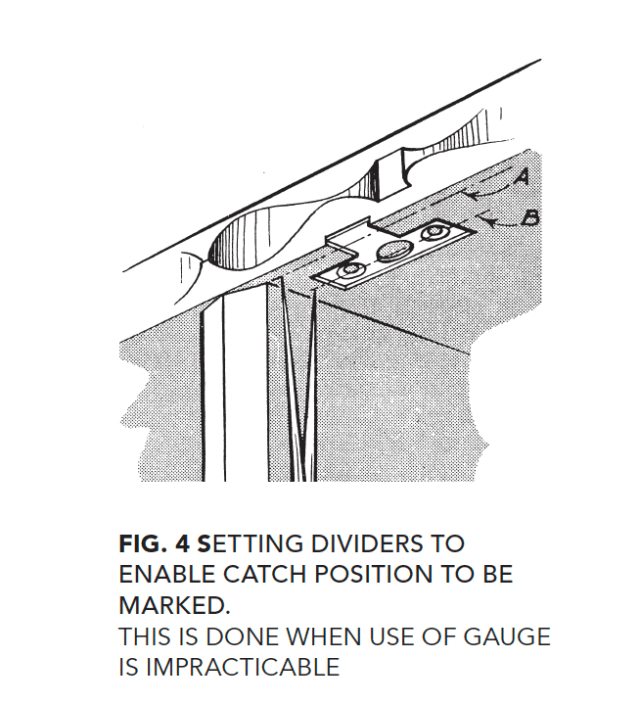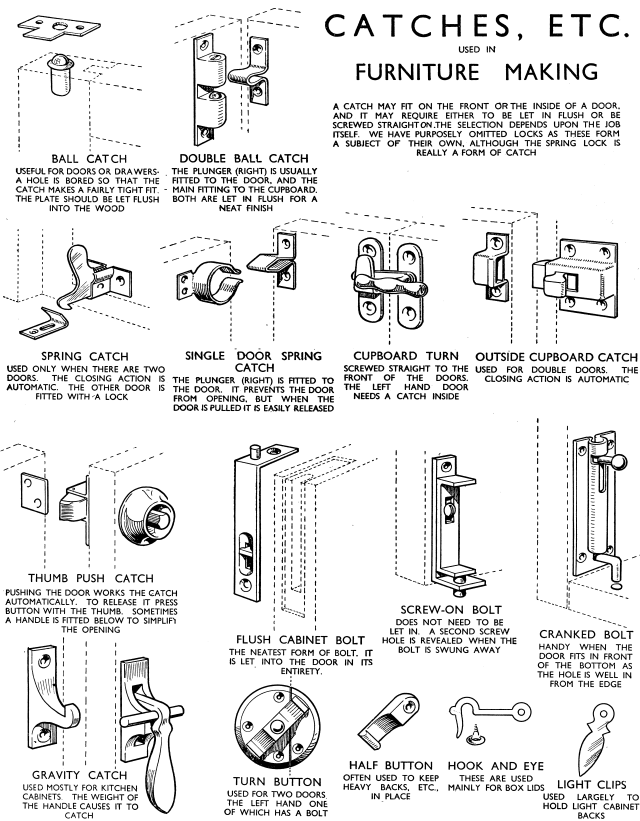
The following is excerpted from “The Woodworker: The Charles H. Hayward Years,” Vol. 4, which covers three different topics.
1) The Workshop, including the design and construction of workbenches, tool chests and wall cabinets. There’s also an entire section devoted to “appliances,”which are workshop accessories such as shooting boards.
2) Furniture & its Details, includes a discussion of all the important Western furniture styles, including their construction, mouldings and metal hardware. This section also includes the construction drawings for many important and famous pieces of furniture examined by Charles H. Hayward during his tenure at The Woodworker magazine.
3) Odds & Sods. In addition to offering its readers practical information for the shop, The Woodworker also asked it subscribers to think about the craft and its place in modern society. We have included many of our favorite philosophical pieces in this final section.
During the last few years the ball catch has become remarkably popular. It is far neater than the old-fashioned turn and is much more convenient in use. There are many occasions when a door needs something to hold it in place when closed but when a lock seems unnecessary. Take, for instance, a sideboard. Often enough locks are not really needed. The key is invariably kept in the lock and it is turned merely to prevent the door from remaining ajar and looking untidy. A ball catch would answer the purpose equally well.
Although the fitting is usually a straightforward job, there are sometimes slight complications. In any case the requirements of the fitting should be understood properly. In the first place, the ball catch itself has a slight flange at the top. When recessed into the door this flange is bound to project. This means that the catch plate must be sunk into the cupboard by an amount rather more than its thickness. If this were not done the flange would strike against the plate and would prevent the door from closing—unless the door was a very loose fit. This is made clear in Fig. 1.

When the door closes in flush with the cupboard the work is simple. First make a pencil line in the middle of the stile at the top and square it across the top edge of the door. Close the latter and transfer the mark to the edge of the cupboard as shown in Fig. 2. Square the mark back for about 1 in. Since the projecting part of the plate must be flush with the front of the cabinet, a gauge can be set to the over-all width (see A, Fig. 3) and the cupboard marked. Holding the plate level with this line and so that the pencil line runs exactly across its centre, mark round it with a marker or sharp pencil. The recess is cut easily by chopping down all round the shape and easing away the waste. The chisel should be placed a trifle inside the line so that the recess is not too large. After a little experience the exact position in which to place the chisel will come automatically, giving a perfect fit. In some fittings the screw holes are pressed out to form a countersink, and this necessitates countersinking the screw holes in the wood to enable the plate to go in flush. Another recess is also needed at the centre where the hole for the ball occurs. This again is best done with the countersink. The ball catch itself merely needs a hole drilled in the door. It is made a fairly tight fit and requires no other fixing.

The fixing is sometimes complicated by the front of the cabinet being chamfered, or having some carved decoration. This prevents the gauge from being used. Proceed as before, marking the pencil line at the top of the door and transferring it to the cabinet. Fit the plate first. Hold it centrally over the pencil line and keep the projecting part of the plate level with the cabinet front (Fig. 4). Having fixed the plate, close the door and mark with a pencil the position its front occupies (see A, Fig. 4). Set a pair of dividers from this pencil line to a line running through the centre of the hole for the ball (B). (This usually lines up with the screw holes.) With the dividers mark the line on the top of the door, keeping one leg of the dividers at the front. This gives the position for the hole for the ball catch.

/*<![CDATA[*/
(function () {
var scriptURL = 'https://sdks.shopifycdn.com/buy-button/latest/buy-button-storefront.min.js';
if (window.ShopifyBuy) {
if (window.ShopifyBuy.UI) {
ShopifyBuyInit();
} else {
loadScript();
}
} else {
loadScript();
}
function loadScript() {
var script = document.createElement('script');
script.async = true;
script.src = scriptURL;
(document.getElementsByTagName('head')[0] || document.getElementsByTagName('body')[0]).appendChild(script);
script.onload = ShopifyBuyInit;
}
function ShopifyBuyInit() {
var client = ShopifyBuy.buildClient({
domain: 'lost-art-press-test.myshopify.com',
storefrontAccessToken: 'f83226aac752f3a8e262f8a8273c9739',
});
ShopifyBuy.UI.onReady(client).then(function (ui) {
ui.createComponent('collection', {
id: '166162563135',
node: document.getElementById('collection-component-1683818383076'),
moneyFormat: '%24%7B%7Bamount%7D%7D',
options: {
"product": {
"styles": {
"product": {
"@media (min-width: 601px)": {
"max-width": "calc(25% – 20px)",
"margin-left": "20px",
"margin-bottom": "50px",
"width": "calc(25% – 20px)"
},
"img": {
"height": "calc(100% – 15px)",
"position": "absolute",
"left": "0",
"right": "0",
"top": "0"
},
"imgWrapper": {
"padding-top": "calc(75% + 15px)",
"position": "relative",
"height": "0"
}
},
"title": {
"font-size": "16px"
},
"button": {
"font-size": "14px",
"padding-top": "15px",
"padding-bottom": "15px",
"border-radius": "11px"
},
"quantityInput": {
"font-size": "14px",
"padding-top": "15px",
"padding-bottom": "15px"
}
},
"text": {
"button": "Add to cart"
}
},
"productSet": {
"styles": {
"products": {
"@media (min-width: 601px)": {
"margin-left": "-20px"
}
}
}
},
"modalProduct": {
"contents": {
"img": false,
"imgWithCarousel": true,
"button": false,
"buttonWithQuantity": true
},
"styles": {
"product": {
"@media (min-width: 601px)": {
"max-width": "100%",
"margin-left": "0px",
"margin-bottom": "0px"
}
},
"button": {
"font-size": "14px",
"padding-top": "15px",
"padding-bottom": "15px",
"border-radius": "11px"
},
"quantityInput": {
"font-size": "14px",
"padding-top": "15px",
"padding-bottom": "15px"
},
"title": {
"font-family": "Helvetica Neue, sans-serif",
"font-weight": "bold",
"font-size": "26px",
"color": "#4c4c4c"
}
},
"text": {
"button": "Add to cart"
}
},
"option": {},
"cart": {
"styles": {
"button": {
"font-size": "14px",
"padding-top": "15px",
"padding-bottom": "15px",
"border-radius": "11px"
}
},
"text": {
"total": "Subtotal",
"button": "Checkout"
}
},
"toggle": {
"styles": {
"count": {
"font-size": "14px"
}
}
}
},
});
});
}
})();
/*]]>*/